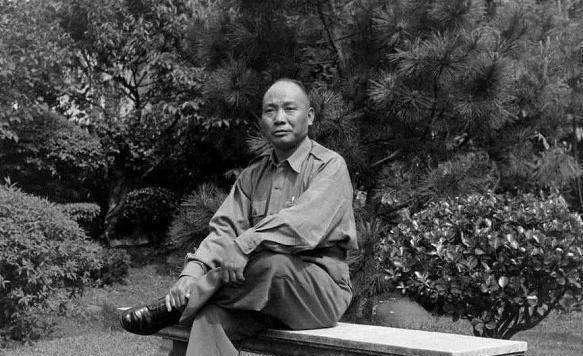On May 12, 2008, the TV series "Red Sun" premiered on Qilu TV. The main story of the play is that the leaders of the Republic of China government tore up the peace agreement and launched an all-out attack on the liberated areas. The East China Field Army engaged the enemy 74th Division in northern Jiangsu and Shandong. In the end, the 74th Division was wiped out by our army at Menglianggu. Li Tianxia in the play is portrayed as a demon, a shameless villain who only knows infighting, ignores the overall situation, and sees profit and forgets righteousness. However, the real Li Tianxia in history is not like this.

Born into a well-to-do merchant family in Baoshan County, Jiangsu Province, Li Tianxia joined the army at the age of 18 and graduated from the third phase of the Whampoa Military Academy. Before the outbreak of the War of Resistance Against Japan, he repeatedly opposed our army, attacked our army, and suppressed the revolutionary forces. In August 1937, when the Songhu Anti-Japanese War broke out, the 30-year-old Li Tianxia, deputy commander of the 51st Division and brigade commander of the 153rd Brigade, was ordered to hold the area around caowang temple and fought fiercely with the Japanese Kurume Division for several months. In mid-November, he led his troops to hold on to Wangting to block the westward advance of the Japanese Kou, and fought a bloody battle with the Japanese army for three days at the No. 137 Bridge of the Beijing-Shanghai Railway, successfully completing the task of covering the retreat of friendly troops.
In December, Li Tianxia led his army to participate in the defense of Nanjing. On the 4th, he commanded the 51st Division to fight twice as many Japanese troops as himself for 5 days and nights in Chunhua Town, and held his position. When the attack was blocked, the Japanese sent aircraft to indiscriminately bombard position 51 and cooperate with infantry and artillery. The 51st Division suffered heavy casualties and the town of Chunhua fell. Then, Li Tianxia guarded the nanjing city wall according to the orders of her superiors. He led his soldiers in a desperate battle with the Japanese army, and the war was in a state of stalemate. Nanjing was about to fall, and he led the 51st Division to break through, preserving some of his troops. On the 13th, Nanjing fell.
In May 1938, Li Tianxia followed his troops to Jiangsu to participate in the Battle of Xuzhou. Soon, his superiors ordered him to move to the Mahuiling Defensive Line in Jiangxi to participate in the battle. During the Battle of Wuhan, he was temporarily transferred to the 40th Division of the Twenty-ninth Army as a division commander, and led his troops to deal a heavy blow to the Japanese army in the battle of holding Lushan. In June of the following year, he was promoted to commander of the 51st Division of the 74th Army, and was sent to Gao'an, Jiangxi to fight against the Japanese forces of two divisions, and participated in the later famous Battle of Shanggao in Jiangxi.
On March 19, 1941, more than 8,000 Japanese troops of the Ikeda Brigade set out from Yidu Street in an attempt to cross the Jinjiang River, giving the Chinese army in Shanggaodi a fatal blow from behind. After learning of the enemy's attempt, Li Tianxia was ordered to go forward to intercept the Japanese army and ambush them on the south bank of the Jinjiang River. When the enemy's four large ships entered the ambush circle, he immediately had the mountain artillery battalion and the heavy machine gun company launch a fierce attack on the Japanese. Four large enemy ships were sunk and most of the Japanese were wiped out. After that, he led his troops to cooperate with other troops to cut off the retreat of the Japanese army, causing heavy casualties for the Japanese army. After the Battle of Shanggao, the 74th Army was known as the Anti-Japanese Iron Army, and Li Tianxia's 51st Division received the first "Army, Navy and Air Force Martial Arts Certificate".
In early 1943, Li Tianxia was promoted to deputy commander of the 74th Army for meritorious service, and concurrently served as the commander of the Zhenyuan Division in Guizhou, responsible for training new recruits of the 74th Army and promoting anti-Japanese resistance. In March of the following year, he was promoted to commander of the 100th Army. He encouraged the soldiers to kill the enemy bravely, and formulated two slogans - "The cause of the army is on the battlefield, and the glory of the army is to win the battle!" Subsequently, Li Tianxia participated in the Battle of Changheng and the Battle of Shaoyang. In February 1945, he was promoted to major general.
In April, Li Tianxia led her troops to participate in the final battle of the War of Resistance Against Japan, the "Battle of Xuefeng Mountain". More than 30,000 men of the Japanese 116th Division attacked them, and the 100th Army under his leadership killed the prestige. In the end, the battle annihilated more than 12,500 enemy troops and wounded more than 23,300 people.
In the War of Resistance Against Japanese Aggression, Li Tianxia made outstanding achievements in battle and made great contributions to the victory of the war. Therefore, it is not possible to one-sidedly learn about a historical figure from certain TV series.